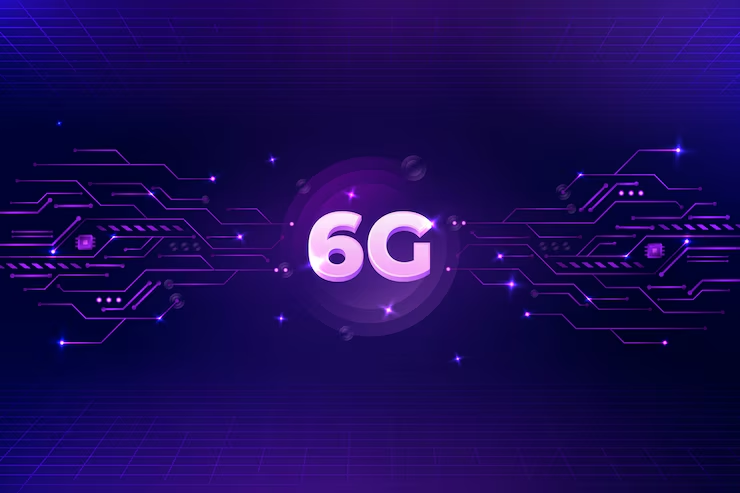This article explores the India 6G network technology roadmap, its expected benefits, challenges, and how it will transform the lives of billions of Indians in the coming decade.
The India 6G network technology roadmap is examined in this article along with its anticipated advantages, difficulties, and potential to change the lives of billions of Indians over the next ten years.
6G technology: what is it?
5G was replaced by sixth-generation wireless communication technology, or 6G. It promises massive device-to-device communication, ultra-low latency, and ultra-high-speed connectivity. A genuinely intelligent and automated society will be made possible by the network, which will link not just people but also machines, cars, and smart gadgets.
Important 6G Features:
✅ Speeds up to 1 Terabit per second (Tbps)
✅ Latency below 1 millisecond
✅ Integration of Artificial Intelligence (AI) and Machine Learning (ML) in network management
✅ Support for Extended Reality (XR), Holographic Communication, and Metaverse Applications
✅ Seamless Internet of Things (IoT) connectivity for billions of devices
India’s Sixth Generation Vision: A Summary
Prime Minister Narendra Modi unveiled India’s plan to roll out 6G services by 2030 on March 23, 2023, with the introduction of the Bharat 6G Vision Document. The Department of Telecommunications (DoT) has started coordinating efforts with academic institutions, industrial partners, and think tanks to establish India as a worldwide center for 6G production and innovation.
Mission 6G India: Principal Goals
🔹 Make India a major player in the world’s 6G technology development
🔹 Make connectivity accessible and affordable to close the digital divide between rural and urban areas
🔹 Encourage self-reliance (Atmanirbhar Bharat) in telecom hardware and software
🔹 Boost India’s standing in international standard-setting bodies
India’s 6G Network Roadmap: Important Turning Points

Research and Development Phase 1 (2023–2025):
Establishment of the 6G Technology Innovation Group (TIG)
Government funding for R&D totaling ₹5000 crore (about $600 million)
Collaborations with IITs, IISc, and leading institutions; Creation of testbeds, prototypes, and proof-of-concept trials
Trials and Standardization Phase 2 (2025–2027):
Field tests of key 6G technologies such as Quantum Communication, AI-integrated Networks, and Terahertz Communication
Collaboration with foreign partners (Japan, South Korea, and the EU) and
participation in international standard organizations including the IEEE, 3GPP, and ITU
Commercial Rollout Phase 3 (2028–2030):
Spectrum Allocation for Terahertz Bands (100 GHz–1 THz)
Pilot services are launched in smart cities and industrial hubs
nationwide deployment is scheduled for 2030.
India’s 6G Vision is Being Driven by Technologies
First Terahertz (THz) Transmission
makes it possible to send data at terabit speeds, which is ideal for 3D communication, XR, and holograms
Networks Driven by Artificial Intelligence (AI)
Network traffic optimization, dynamic resource management, and uninterrupted connection are all made possible by AI and ML.
Quantum Communication Sensitive data is
protected by ultra-secure communication using Quantum Key Distribution (QKD).
Internet based on satellite
In order to guarantee coverage throughout India, particularly in distant areas,
ISRO is supporting satellite communication systems.
Sustainable and Green Networks
6G uses energy-efficient technology to lower energy use and carbon emissions.
6G’s obstacles in India
High Infrastructure Cost: A substantial investment is required to develop THz communication and AI systems.
Spectrum Allocation: It is essential to manage new frequency bands effectively.
Skilled Labor: It’s essential to upskill engineers and researchers.
Cybersecurity Risks: Complex security threats might arise from faster networks.
Global Competition: India needs to stay up with nations like the US, China, Japan, and the EU.
International Partnerships: Enhancing India’s Role
India is currently working to develop 6G standards with partners across the world:
Participation in the ITU’s 6G Focus Group
the Japan-India 6G Collaboration Agreement
and the EU-India Strategic Partnership on Digital Infrastructure
These collaborations will guarantee that India’s inventions are acknowledged internationally and advance global norms.
Conclusion: 6G Holds Great Promise for the Future
India’s 6G strategy aims to build a future-ready digital environment that empowers people, strengthens the economy, and positions India as a worldwide leader in technology, not simply faster internet. By 2030, India is poised to lead the world in 6G technology thanks to its investments in R&D, innovation, and international cooperation.
To receive the most recent information about India’s 6G effort, follow TazaKhbar!










